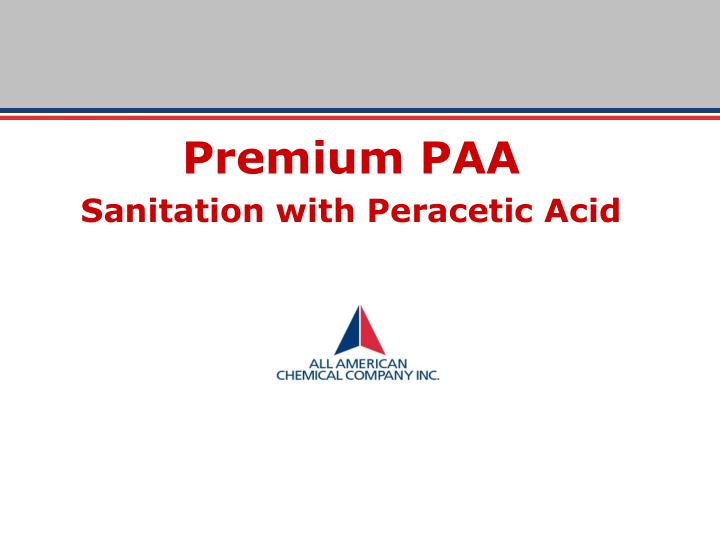



Premium PAA Sanitation with Peracetic Acid
Outline Chemistry Microbiology – efficacy Regulatory Approvals Safety Handling – how to use Q & A
What Is Premium PAA? Activity • Peracetic acid (PAA) 15% • Hydrogen peroxide 22% • Specific Gravity 1.12 H2O2 + CH3COOH CH3COO-OH + H2O
OXIDATION POTENTIAL PAA VS OTHER OXIDANTS (e - VOLTS) 2.5 2 Ozone 1.5 PAA Chlorine Dioxide 1 Chlorine Bromine 0.5 0 oxidation capacity
PAA Efficacy (Bacteria) In the Presence of Hard Water and High Organic Load ppm required for lethality in < five minutes 900 800 700 600 PAA 500 Chlorine 400 Quat 300 200 100 0 L. monocytogenes S. aureus E. faecium
Conclusion PAA is less affected by organic load (soil) than either chlorine or Quaternary (Quat) sanitizers .
Premium PAA Efficacy on Food Bacteria 80 ppm PAA (1 oz per 6 gal water) Species log kill* time (sec ) Salmonella choleraesuis >7.04 30 Listeria monocytogenes >5.0 30 Staphylococcus aureus >6.88 30 Escherichia coli >6.94 30 * All organisms pass the AOAC Germicidal and Detergent Sanitizing Action of Disinfectants Test
Premium PAA Efficacy on Food Microorganisms 1000 ppm PAA at 46° C Species Control* Log kill* time (sec) Bacillus subtilis 6.2 >6.2 15 (Spoilage bacteria) Byssochlamys fulva 5.1 >5.1 15 (Fungus) Aspergillus niger 5.1 > 5.1 15 (Yeast) * Log 10
Premium PAA SHOWS A COMPLETE KILL AT 9 PPM, IN 3 HOURS (LOG REMAINING) 9 8 7 6 5 Control 3 hours 4 6 hours 3 2 1 0 Bacteria Yeast Algae
Premium PAA Sanitation of Food Processing Equipment Fruit & vegetable processing Beverage plants – high level sanitation of bottles Wineries, breweries Meat, poultry, seafood and egg plants Used in High Pressure Kobe systems in all the above
Premium PAA Sanitation Properties • Disperses/penetrates biofilms • Kills bacteria, mold, fungus, and yeast • Very fast acting • Unaffected by hardness and soil • Non-foaming • Does not contribute taste, odor or color • No rinse required
Premium PAA Sanitation Properties • Does not form disinfection byproducts • Breaks down into carbon dioxide and water • Does not add conductivity (TDS) • Non-corrosive to stainless steel, aluminum • No RMP requirement • Easily dispensed as a liquid • Easy to test for
Premium PAA PAA Sanitation-Regulatory • EPA approved as a pesticide – 40 CFR 152.25 (a) EPA #63838-1 • FDA approved for direct food contact – 21 CFR 173.315 (fruits, vegetables) – 21 CFR 173.370 (meat, poultry, seafood) • FDA approved as sanitizer on food contact surfaces – 21 CFR 178.1010
Premium PAA PAA In/On Food • Approved for direct fruit and vegetable contact without a final rinse. Limit is 80 ppm as PAA for direct food contact Limit is 500 ppm as equipment sanitizer (without a potable water rinse) (40 CFR 180.1197) • Other uses include dip (wash) tanks, sprays, continuous belt sprays, cooling water, etc.
Premium PAA Approvals • National Organic Program – Approved Nov 17, 2000 • NSF approved for fruit and vegetable washing without a final rinse – Registration No. 122280 • Kosher approved including Passover – Pareve, Kashruth Certification
Premium PAA Safety and Handling Storage: • PAA solutions should be kept in cool environments when possible. • Never store a PAA drum outdoors in a bright sunlight without protecting the tops from direct sun. Sunlight will increase the temperature in the headspace of a drum, and the gas may expand faster than the venting membrane devices will allow.
Premium PAA Safety and Handling Miscellaneous safety: • NEVER place or pour concentrated PAA solutions into any type of other holding device, such as ‘shot’ feeders, day tanks, or any other type of container, unless it is dedicated for PAA and is made of compatible materials. • As a rule, add PAA solutions to water only.
Premium PAA Safety and Handling • NEVER return PAA solutions back to the original container once it is removed. The slightest contamination may degrade the product remaining in the drum, or may set off a decomposition reaction, which evolves oxygen and heat. • ALWAYS wear gloves, goggles or faceshield, and other appropriate chemical resistant gear when handling peroxyacetic acid products.
Recommend
More recommend